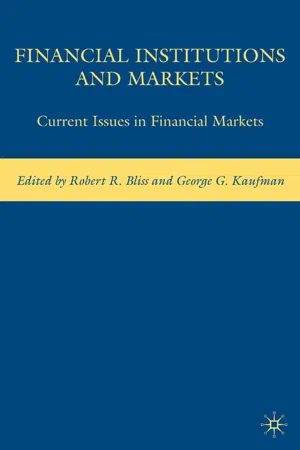Economics
Bank Failure
Bank failure occurs when a bank is unable to meet its financial obligations, leading to insolvency and closure. This can result from a range of factors, including poor management, economic downturns, or excessive risk-taking. The consequences of bank failure can be far-reaching, impacting depositors, borrowers, and the broader financial system.
Written by Perlego with AI-assistance
7 Key excerpts on "Bank Failure"
- eBook - PDF
Financial Institutions and Markets
The Financial Crisis: An Early Retrospective
- G. Kaufman, R. Bliss, G. Kaufman, R. Bliss(Authors)
- 2012(Publication Date)
- Palgrave Macmillan(Publisher)
If failure is not prevented, it is feared that the adverse implications may be transmitted beyond the insolvent bank or banks to other financial institutions, financial markets, and ultimately the macro- economy. This would occur primarily through two routes: (1) credit losses, and (2) liquidity losses suffered by customers of the insolvent bank(s). Credit losses to depositor and other unsecured creditors of insolvent institutions occur when the recovery value of a bank’s assets fall short of the par value of its deposits and other creditor claims at the time that the regulators officially recognize the bank’s insolvency, revoke its charter, and place it in receivership or conservatorship. Liquidity losses to both depositors and borrowers at insolvent institutions occur when these parties are denied continued uninterrupted access to their claims at the time a bank is officially failed, for depositors and other creditors gener- ally until the proceeds from the sale of the bank or its component assets are realized. 1 Thus, the bank’s depositors may be denied immediate or near-immediate access to the par value of their insured deposits and the estimated recovery value of their uninsured deposits and the bank’s per- forming borrowers, including credit card holders, may be denied access to their remaining existing credit lines. The claims are effectively frozen for BASEL II 149 a meaningful period of time. Short-term creditor claims are transformed into longer-term claims. Liquidity losses are not only a major inconve- nience to the failed bank’s customers, but are likely to significantly reduce the efficiency of the payments system and the value of aggregate wealth. Although, at least in the United States, liquidity losses receive less attention than credit losses, their adverse consequences are often as great or greater than credit losses. - eBook - PDF
Pursued Economy
Understanding and Overcoming the Challenging New Realities for Advanced Economies
- Richard C. Koo(Author)
- 2022(Publication Date)
- Wiley(Publisher)
If a bank faces an excessively large outflow of funds (or the interbank market becomes dysfunc- tional), it can go to the central bank to borrow the funds needed to make the payment. Since the advent of central banks, virtually all payments between banks have been settled through accounts they have with the central bank. In the United States these are known as “fed funds.” Regarding the second function of banks, bank capital may fall below the required minimum when losses are incurred on NPLs. When that happens, banks must abstain from lending because their capital is not considered sufficient to absorb the associated risks. And Money and Banking in the Other Half of Macroeconomics 329 when such capital problems prevent many banks from lending, the economy faces a predicament known as a credit crunch. The entire economy suffers when banks are unable to lend the savings entrusted to them because saved funds cannot re-enter the economy’s income stream even if there is a plentiful supply of bor- rowers. Indeed, this lender-side problem can also trigger the $1,000– $900–$810–$730 deflationary spiral. These lender-side difficulties, when coupled with borrowers’ debt overhang problems, throw the economy into Case 4. The potential for a dysfunctional banking system to damage the entire economy means there are large externalities to the bank- ing business. Since banks’ continued functioning is essential to the economy, government cannot treat them like any other private-sector business. That is why banks in every country are closely supervised by the government. When problems arise in the banking sector, the government and the central bank are expected to implement the sorts of policies that are described under Case 2 in Chapter 1 to ensure that banking functions are maintained. For example, if the interbank market has become dysfunctional, the central bank is expected to act as lender of last resort to help banks experiencing net outflows. - eBook - PDF
Unsettled Account
The Evolution of Banking in the Industrialized World since 1800
- Richard S. Grossman(Author)
- 2010(Publication Date)
- Princeton University Press(Publisher)
At what point do individual Bank Failures become a banking crisis? Lindgren, Garcia, and Saal (1996: 9) define a sound banking system as one in which: . . . most banks (those accounting for most of the system’s assets and li-abilities) are solvent and likely to remain so. Solvency is reflected in the positive net worth of a bank, as measured by the difference between assets and liabilities . . . In contrast, Bordo et al. (2001: 55), relying on Caprio and Klingebiel (1996, 1999), assert that a banking crisis occurs when financial distress leads to “. . . the erosion of most or all of aggregate banking system capital.” Although the gap between sound (“most banks solvent”) and unsound (“most bank capital eroded”) banking systems under the above definitions is wide, it is clear from both that an isolated Bank Failure does not constitute a banking crisis. Both of the above definitions rely on measures of bank capital, which is unfortunate for two reasons. First, although soundness is straightfor-ward to define in terms of the ratio of capital to total assets, in practice it is quite difficult to measure, since loans—the largest component of bank assets—and capital are notoriously difficult to value at any given time. 1 Second, although low capital-to-asset ratios are often symptomatic of an ailing bank or banking system and the erosion of most (a vague standard) or all banking capital would certainly constitute a crisis, some banks and banking systems have survived with low levels of capital, and other seem-ingly well-capitalized banking systems have plunged into crisis. Friedman and Schwartz (1963), in their classic volume on American monetary history, assert that banking crises should be defined by changes in the currency-to-deposit ratio. As deposits are withdrawn from banks 1 Traditionally, bank balance sheets have valued both loans and capital at book (histori-cal) value rather than being “marked-to-market,” or stated at market value. - Richard C. Koo(Author)
- 2018(Publication Date)
- Wiley(Publisher)
CHAPTER 8 Banking Problems in the Other Half of MacroeconomicsWhen a bubble bursts, the economy typically faces an absence of both lenders and borrowers (Case 4). Lenders disappear from the scene because they lent money to participants in the bubble, many of whom became insolvent when the bubble burst. The resultant increase in non‐performing loans (NPLs) erodes banks’ capital, leaving them unable to lend. In fact, many lenders may find themselves effectively bankrupt.Two Externalities of Banking System
When impaired balance sheets leave banks unable to function fully, the broader society suffers in two ways. First, banks are at the core of the settlement system. Because everything from utility bills to college tuition is paid via the banking system, a breakdown here can have a devastating impact on the economy. Banks’ second function is to ensure that saved funds are borrowed and spent, thereby keeping the economy functioning. A failure of this function will lead to the sort of $1,000–$900–$810–$730 deflationary spiral discussed earlier.On the first point, banks have to make hundreds of thousands of payments on behalf of depositors for a wide variety of purposes every day. In making those payments, banks are merely passive executors of requested transactions. They have no prior knowledge of when a depositor will purchase something or what the price will be.A bank also receives a large number of payments on behalf of depositors from depositors at other banks. But there is no guarantee that the payments it receives one day will match the payments it has to make to other banks that day. To deal with this daily but significant uncertainty, interbank markets and central banks were created to ensure that banks always have enough reserves to meet payment requirements.The interbank market was created to allow banks with net inflows to lend their surplus reserves to banks experiencing net outflows. Since the aggregate inflows and outflows for the banking system should sum to zero, a fully functioning interbank market should keep the payment system from running into difficulties.- eBook - PDF
- P. Arestis, P. Arestis, Kenneth A. Loparo, Malcolm Sawyer(Authors)
- 2015(Publication Date)
- Palgrave Macmillan(Publisher)
162 5 Systemic Failure of Private Banking: A Case for Public Banks Costas Lapavitsas Department of Economics, SOAS Abstract The crisis of 2007–9 represents a systemic failure of private banking. The private nature of banks has created opacity, and exacerbated problems of liquidity, bad assets and capital shortage. Furthermore, private banks have failed in information gathering and risk management, as well as in mediating the acquisition of vital goods by households. It is paradoxical that, confronted with such systemic failure, Keynesian and other het- erodox economists have generally made non-systemic reform proposals. This paper draws on Marxist theory to argue that systemic change is necessary, including conversion of failed private into public banks run transparently and with democratic accountability. Public banks could more easily confront the problems of liquidity and solvency; they could also play a long-term role by providing stable flows of credit to house- holds as well as to small and medium-sized enterprises. JEL Classification Codes: E11, E12, G21, G28 Keywords: Banking, financial crisis, financial regulation, Keynesianism and Marxism 1. Introduction At the core of the current crisis lies a systemic failure of private banking – both commercial and investment. The failure is systemic because the crisis has been caused by the interaction of several com- ponents of the financial system, and, above all, the banks. No single element of finance has been uniquely at fault, and nor has the turbu- lence been caused by malpractice in a small number of institutions. Costas Lapavitsas 163 The failure is also systemic because several large commercial banks in the USA, the UK and elsewhere were effectively bankrupt during 2008–9. 1 Had governments allowed these to fail, it is probable that there would have been a general banking collapse. Yet, mere prevention of bankruptcy through extraordinary measures has not resolved the underlying systemic banking problems. - Robert M Stern, Simon J Evenett(Authors)
- 2011(Publication Date)
- World Scientific(Publisher)
1 Banks are in the business of borrowing short and lending long. In doing so they provide an essential service 1 A very useful book is Goodhart and Illing, (2002). 23 24 P. De Grauwe to the rest of us, i.e., they create credit that allows the real economy to grow and expand. This credit creation service, however, is based on an inherent fragility of the banking system. If depositors are gripped by a collective movement of distrust and decide to withdraw their deposits at the same time, banks are unable to satisfy these withdrawals as their assets are illiquid. A liquidity crisis erupts. In normal times, when people have confidence in the banks, these crises do not occur. But confidence can quickly disappear, for example, when one or more banks experience a solvency problem due to non-performing loans. Then, bank runs are possible. A liquidity crisis erupts that can also bring down sound banks. The latter become innocent bystanders that are hit in the same way as the insolvent banks by the collective movement of distrust. The problem does not end here. A devilish interaction between liq-uidity crisis and solvency crisis is set in motion. Sound banks that are hit by deposit withdrawals have to sell assets to confront these with-drawals. The ensuing fire sales lead to declines in asset prices, reduc-ing the value of banks’ assets. This in turn erodes the equity base of the banks and leads to a solvency problem. The cycle can start again: the solvency problem of these banks ignites a new liquidity crisis and so on. The last great banking crisis occurred in the 1930s. Its effects were devastating for the real economy. After that crisis the banking system was fundamentally reformed. These reforms were intended to make such a banking crisis impossible. The reforms had three essential ingre-dients. First, the central bank took on the responsibility of being the lender of last resort. Second, deposit insurance mechanisms were insti-tuted.- eBook - PDF
Financial Institutions and Markets
Current Issues in Financial Markets
- G. Kaufman, R. Bliss, G. Kaufman, R. Bliss(Authors)
- 2008(Publication Date)
- Palgrave Macmillan(Publisher)
However, their relative importance varies. First, there is a greater need for speed in handling the resolution of financial failures, and second, financial failures of large finan- cial institutions can generate significant negative externalities and therefore give rise to public interest concerns. 9 The goal to achieve comity among private (creditor and debtor) interests is therefore affected by the need to take account of the public interest. Financial institutions only operate efficiently to the extent that market participants have confidence in their ability to perform the roles for which they were designed. The more sophisticated the economy and the greater its dependence on financial promises, the greater is its vulnerability to fail- ure of the financial system to deliver against its promises. Even when they are solvent, financial institutions can quickly become illiquid if something happens to cast doubt on their ability to meet their payment obligations. This is because the liquidity mismatch between assets and deposits gives rise to the risk that depositors run to withdraw their funds. A run can be triggered by bad news about the value of bank assets or by any unexplained fear. In either case, there may be a loss, since illiquid assets will be sold at a discount. Moreover, a Bank Failure can eventually trigger a signal on the solvency of other banks, leading to a systemic crisis. What changes in the case of an LCFI is merely the nature of the counterparties and the nature of the financial contracts, namely commercial paper, structured products, and other wholesale instruments, the treatment of which in insolvency is largely untested. The need for speed and the potential for financial failure to result in systemic instability explain why crisis procedures for financial firms differ from ordinary insolvency procedures.
Index pages curate the most relevant extracts from our library of academic textbooks. They’ve been created using an in-house natural language model (NLM), each adding context and meaning to key research topics.






